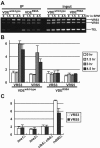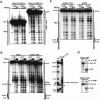Investigation of the mechanism of meiotic DNA cleavage by VMA1-derived endonuclease uncovers a meiotic alteration in chromatin structure around the target site
- PMID: 16757746
- PMCID: PMC1489271
- DOI: 10.1128/EC.00052-06
Investigation of the mechanism of meiotic DNA cleavage by VMA1-derived endonuclease uncovers a meiotic alteration in chromatin structure around the target site
Abstract
VMA1-derived endonuclease (VDE), a homing endonuclease in Saccharomyces cerevisiae, is encoded by the mobile intein-coding sequence within the nuclear VMA1 gene. VDE recognizes and cleaves DNA at the 31-bp VDE recognition sequence (VRS) in the VMA1 gene lacking the intein-coding sequence during meiosis to insert a copy of the intein-coding sequence at the cleaved site. The mechanism underlying the meiosis specificity of VMA1 intein-coding sequence homing remains unclear. We studied various factors that might influence the cleavage activity in vivo and found that VDE binding to the VRS can be detected only when DNA cleavage by VDE takes place, implying that meiosis-specific DNA cleavage is regulated by the accessibility of VDE to its target site. As a possible candidate for the determinant of this accessibility, we analyzed chromatin structure around the VRS and revealed that local chromatin structure near the VRS is altered during meiosis. Although the meiotic chromatin alteration exhibits correlations with DNA binding and cleavage by VDE at the VMA1 locus, such a chromatin alteration is not necessarily observed when the VRS is embedded in ectopic gene loci. This suggests that nucleosome positioning or occupancy around the VRS by itself is not the sole mechanism for the regulation of meiosis-specific DNA cleavage by VDE and that other mechanisms are involved in the regulation.
Figures





Similar articles
-
Homing at an extragenic locus mediated by VDE (PI-SceI) in Saccharomyces cerevisiae.Yeast. 2002 Jun 30;19(9):773-82. doi: 10.1002/yea.872. Yeast. 2002. PMID: 12112231
-
VDE-initiated intein homing in Saccharomyces cerevisiae proceeds in a meiotic recombination-like manner.Genes Cells. 2003 Jul;8(7):587-602. doi: 10.1046/j.1365-2443.2003.00659.x. Genes Cells. 2003. PMID: 12839620
-
Karyopherin-mediated nuclear import of the homing endonuclease VMA1-derived endonuclease is required for self-propagation of the coding region.Mol Cell Biol. 2003 Mar;23(5):1726-36. doi: 10.1128/MCB.23.5.1726-1736.2003. Mol Cell Biol. 2003. PMID: 12588991 Free PMC article.
-
Molecular mechanism of VDE-initiated intein homing in yeast nuclear genome.Adv Biophys. 2004;38:215-32. Adv Biophys. 2004. PMID: 15493335 Review.
-
Reflections on protein splicing: structures, functions and mechanisms.Proc Jpn Acad Ser B Phys Biol Sci. 2009;85(9):409-21. doi: 10.2183/pjab.85.409. Proc Jpn Acad Ser B Phys Biol Sci. 2009. PMID: 19907126 Free PMC article. Review.
Cited by
-
Targeted induction of meiotic double-strand breaks reveals chromosomal domain-dependent regulation of Spo11 and interactions among potential sites of meiotic recombination.Nucleic Acids Res. 2008 Feb;36(3):984-97. doi: 10.1093/nar/gkm1082. Epub 2007 Dec 20. Nucleic Acids Res. 2008. PMID: 18096626 Free PMC article.
-
Conditional genomic rearrangement by designed meiotic recombination using VDE (PI-SceI) in yeast.Mol Genet Genomics. 2007 Oct;278(4):467-78. doi: 10.1007/s00438-007-0264-7. Epub 2007 Jun 22. Mol Genet Genomics. 2007. PMID: 17587055
-
An Evolutionary Perspective on Yeast Mating-Type Switching.Genetics. 2017 May;206(1):9-32. doi: 10.1534/genetics.117.202036. Genetics. 2017. PMID: 28476860 Free PMC article. Review.
References
-
- Burt, A., and V. Koufopanou. 2004. Homing endonuclease genes: the rise and fall and rise again of a selfish element. Curr. Opin. Genet. Dev. 14:609-615. - PubMed
-
- Chu, S., and I. Herskowitz. 1998. Gametogenesis in yeast is regulated by a transcriptional cascade dependent on Ndt80. Mol. Cell 1:685-696. - PubMed
Publication types
MeSH terms
Substances
LinkOut - more resources
Full Text Sources
Molecular Biology Databases
Research Materials

